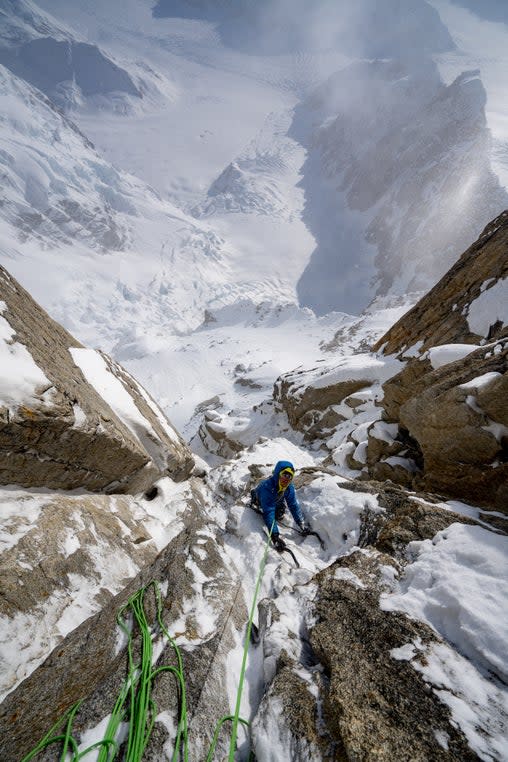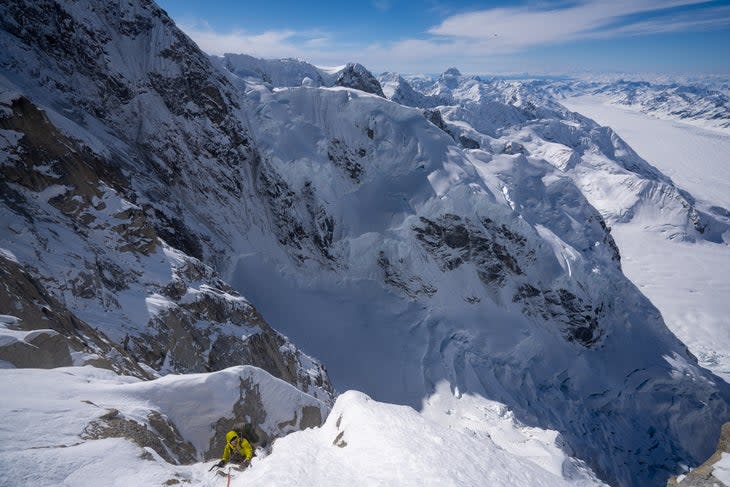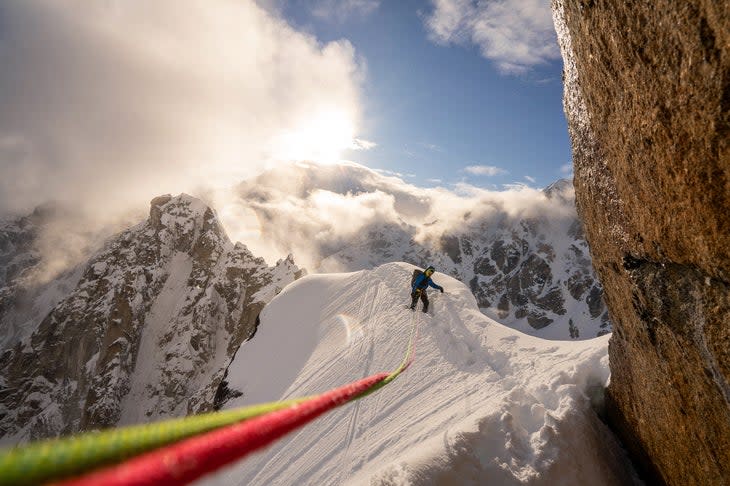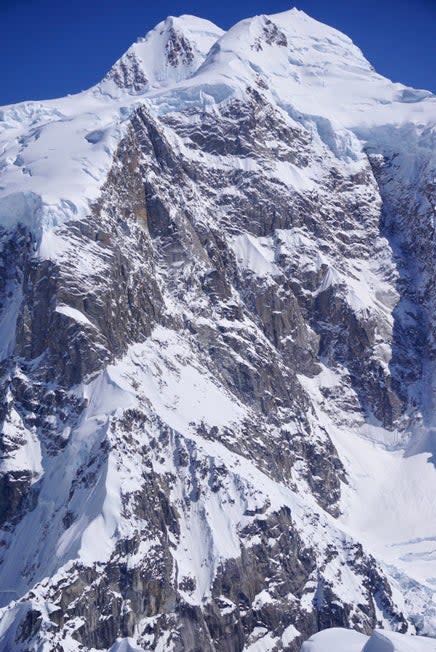Shrinking Serac Opens Up Stout New Route on Mt. Hunter, Alaska
This article originally appeared on Climbing
Clint Helander and August Franzen, both of Alaska, have made a massive first ascent on Mt. Hunter's West Buttress, finding some of the most difficult mixed climbing either of them have experienced while alpine climbing. The 14,537-foot Mt. Hunter (which is often referred to by its Dena’ina name, Begguya), has a striking, golden rock buttress found to the south of its west ridge. As Helander noted, finding unclimbed lines in the central Alaska range is quite challenging, and when you do find such a feature, there is usually a good reason why.
For the West Buttress, which has been named Full Moon Fever (AK 6 M7 A1 AI4; 6,400 feet), that reason was seracs. Helander says that without this hazard the West Buttress would have likely been climbed 30 years ago, but a warming Alaskan climate has caused the looming ice to retreat from the buttress' edge, leaving a safer route in its wake.
Even so, Full Moon Fever is a massive undertaking. The duo left their camp on Friday the 13th, skied up the broken Ramen Glacier (into which Helander took a 25-foot fall on a previous attempt) and, over the next 90 hours, climbed steep, splitter granite, aerated snow, and corniced ridgelines, before tacking on a three-mile traverse from the south to north summit because, as Helander put it, laughing, "why not do something great on top of great?" Indeed, most parties opt out of the summit-plateau slog to the true summit, Hunter's north summit, but Helander says he wanted to make the most of this once-in-a-lifetime experience: an entirely new line up the Alaska range's third tallest peak.

This summit, however, was more powerful than most. "August and I are linked in grief," Helander says, referencing their loved ones who have died while climbing. After Franzen's partner in life, Kalley Rittman, died in an ice-climbing accident in 2020, Helander reached out to him with an invitation to try the West Buttress. "I thought this would be something we could share," Helander says, "given our history with loss." Franzen climbed with Rittman's ashes inside his pack and spread them across the south summit.
When Helander and I spoke, he was in his van, having just finished a 12-hour shift of rope-access work, where he'd worked to mitigate rock-fall hazard after a significant landslide in Seward, Alaska. He'd driven straight there after coming off of his Mt. Hunter ascent. "For the first couple of days I was just burly tired," he says. Helander and I spoke about his horrifying fall into a crevasse; the difficulty of the M7, A1 pitches he and Franzen encountered; the decision to traverse all three of Mt. Hunter's summits; and why he thinks an era of dangerous exploratory alpinism, for him, is drawing to a close. Our conversation had been edited and condensed.
The Interview
Climbing: How many times had you tried this line before?
Helander: This was my second. I don’t think I’m allowed to get meaningful climbs on my first attempt. [Laughs.] This was a line I'd been looking at for the last seven or eight years. Of course, finding unclimbed lines in the central Alaska range is quite challenging. Especially lines that aren't just variations. Seeing that the West Buttress was indeed a major feature but it hadn't been climbed, I thought, "Well, it's got to have some pretty severe objective hazard then."
In 2018, Jess Roskelley, David Lama, and I were thinking about this route as a possible option, while waiting for a window on Mt. Logan. And Roskelley and I always talked about going back--this was going to be a route that we did together.
Climbing: Why do you think this feature had remained unclimbed?
Helander: The only thing I can think of was this big south-facing serac at the top of the buttress. And I'm sure this thing would have been climbed 30 years ago--but the serac would have been just massive back then. And in talking to Paul Roderick (a local pilot and expert of the range) he told me that it had been melting back for the last 15 to 20 years.
Climbing: Can you tell me about your first attempt last year?
Helander: I'd climbed Mt. Hunter to the summit twice before but never with a direct view of the buttress--not from the aspect we needed. So August and I flew in, skied two hours from basecamp, and set up our advanced base camp because we wanted to be close and watch it for a couple of days. Once we got there, we thought it looked good to climb and skied up this very tangled icefall: the Ramen icefall. And man, it's gnarly. As soon as we roped up I said, "All right, well watch me--and we were on skis--and I took a twenty-five-foot crevasse fall.
Climbing: Oh my God.
Helander: Yeah. At the very beginning of the icefall. I was O.K., but all these things rushed through my head as I was falling: I thought I was going to break my leg; I thought I was going to flip upside down; I thought I was going to get wedged. And then, as I kept falling, I thought August was going to come in and we were both going to disappear. It was just all black below me. It was so deep.
Climbing: So August arrested your fall?
Helander: Yeah.
Climbing: That's a proper whip.
Helander: Oh yeah. Huge. I jugged out by myself and I remember popping my head out, flopping over, and my eyes were just huge. August asked "Dude. Are you O.K.?" And I said, "Yep. Let's keep going! It's probably going to happen like three or four more times, so now keep me really tight!" And I never found another crevasse the whole way.
That year we pushed from our camp to the base of the Ramen and, in a 19-hour day, we climbed up the lower ridge, traversed below the serac to the base of the route, and climbed three pitches before the weather broke down. It snowed all night, we got wet in our tent, our one sleeping bag got soaked, and we saw that the climbing above us did not look easy. In the morning it was pretty obvious that we should go down. So we did. But, you know, we’d learned a lot and that's important for routes like this. Oftentimes when you’re exploring--that’s exactly what you’re doing. Every new meter is a ton of questions answered. We came into this year with a lot more knowledge of what to do and how to change our tactics and it worked perfectly.

Climbing: So how did this attempt go?
Helander: It started by teaming up with a group of skiers who wanted to ski the Ramen couloir, and we all worked together to find a way through the icefall, and mark it with wands, which was awesome. We left a cache at the base of the icefall, skied back, and waited for a high pressure system to arrive.
On Friday, we skied through the icefall and climbed the first two pitches to the ridge where we had found a bivy the year before: this awesome bivy under a rock with a big snow scoop. We stayed tied in, but wore just slings around our waists--because, after that whipper I took at Golgotha's bivy...--and had a beautiful, clear night.
The next day we climbed four very hard pitches on the lower headwall, climbed a snow ramp to the left, and then found a perfect bivy, below the upper ramps of the headwall. Those four pitches were among the most challenging granite climbing I’ve done in the mountains. The rock was exquisite. And, unlike Golgotha where there was no rock pro, you could put cams, nuts, and pins in wherever you want. Just high quality granite. There were three pitches that were about M7. (And, for reference, both August and I have climbed The Moonflower Buttress and our crux pitches felt harder and more sustained.) Almost every pitch involved torquing in cracks--or multiple cracks--which was nice. It wasn't that sort of polished mixed climbing, you know, just raking your tool hoping to find something. It was solid torquing.
But we were also doing whatever we had to do. There were times that I'd stand on a cam, or hook my tool into a carabiner, or do whatever we could to advance. On a first ascent, I'm like, "The next team can go free it. I don't give a shit. We're just trying to move."

We knew we wanted to traverse all three summits of Mt. Hunter, and were trying to keep our days relatively short to not totally kill ourselves. On the third day we traversed some really broken granite, weaving our way through rock and snow toward this gigantic prow of rock hanging over the ridge that showed us where we wanted to go. Halfway through the day we were off the buttress and the most challenging part, but we still had thousands of feet to go before even the south summit. We marched for hours into this headwind, August fell through a crevasse, we started crawling over snow bridges on the summit plateau, slowly gaining elevation. As soon as we got up to the south summit we found this perfect calm little zone, where we could see the wind howling just a hundred feet to the north, and we had an amazing night. The next day we began the long, arduous process of ticking off all three summits.
Climbing: What does that traverse entail?
Helander: It's a good ways, probably two to three miles with meandering. And we were postholing--it wasn't just kicking up on firm snow. It was brutal dig-deep-within-your-soul kind of work. Afterwards, people asked, "Why didn't you just do the south summit and go down?" And I thought, "Why not do something great on top of great?" It wouldn't have been any less of a success if we hadn’t, but this was the icing on the cake.
Climbing: How was the descent?
Helander: It was very easy. We went down the west ridge and, from the summit to the base of the Ramen, we took three hours and 10 minutes. And we did zero rappels. Then we slogged nine miles through the Ramen back to basecamp.

Climbing: In a post after your ascent you wrote, "… Maybe I'm ready to ease off the dangerous pursuit of exploratory alpinism a little bit. I have been lucky and I can't help but feel like I've gotten away with a lot." Can you expand on that?
Helander: I had a lot of good years early on when I started alpine climbing, where I didn't lose any friends, and I thought climbing was this blissful thing and that death and tragedy were super removed from me. But, you know, the reason I'm climbing with August is because all the partners my age are either dead or have given up. And, the thing that I have been thinking about lately is just how cool it would be to do something like alpinism and to get away with it. To be one of those people that survived. I'm not saying I'm quitting or anything, but I'm 37; there are other things in my life I'm trying to do. I just got accepted into nursing school. I have other pursuits now whereas, when I was in my twenties, climbing was everything. If I was 10 years younger I wouldn't be working right now, I would be trying to follow the boot tracks of those dudes who just did the Slovak.
The adventures I've had in the last five years (especially Huntington, Golgotha, and this) have been deep, integral projects that I've been pondering in my soul for a long time. And going even bigger than that in the first-ascent realm doesn't really interest me because I know where that leads. It leads to not coming home. Hunter was actually quite safe as a route, but that crevasse fall was a big wake up call. So I'm trying to minimize my time in those dangerous places. I’ll still climb steep, big alpine routes, but I'm going to pick them more selectively in the future.
Anthony Walsh is a digital editor at Climbing.
For exclusive access to all of our fitness, gear, adventure, and travel stories, plus discounts on trips, events, and gear, sign up for Outside+ today.

